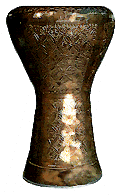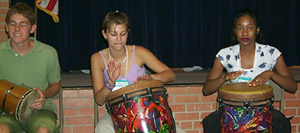| 









|

Drum Circle @ RHYTHMWEB
Home
Middle School Drumming Program
Techniques
 My
sincere thanks to Berklee student Mike Bean for allowing me
to post this e-mail exchange regarding effective drum circle techniques
for middle school students: My
sincere thanks to Berklee student Mike Bean for allowing me
to post this e-mail exchange regarding effective drum circle techniques
for middle school students:
I got this e-mail 5/23/03 from Mike Bean in Boston:
hi Stu,
"I hope you can help me with a suggestion. I am a
music therapy student at Berklee College of Music in Boston and I have
been asked to facilitate a group drumming experience with middle schoolers
at a local school. I have already done one day with them and will be
returning tomorrow. My experience with facilitating is limited but I
have gone through the REMO HealthRhythms training. The few circles I
have facilitated have been with adults using what Arthur Hull calls
"in the moment" music. I have always had at least one other
drummer to help establish a pulse and everyone just played. Once the
groove was going then I could use some orchestration techniques."
"The problem I had with the middle schoolers aside from general
behavioral issues (some of the kids were just wild!) is that we could
not really find a good groove. We had a few moments but I would really
like to make it a great experience for them. I feel that if I could
show them the right parts to play and layer them together we could get
a good groove going."
"Any input would be greatly appreciated! Thank you for your time."
Mike Bean
hi mike
how many kids?
what instrumentation?
eric
Hello again
40 to 50 middle schoolers for 50 minutes at a time - All Remo kids drums
- congas, djembes, bongos. Two large gathering drums- different depths;
2 tamborines with heads, approx. 30 egg shakers. I used a cowbell w/stick
most of the day, large Djembe a couple times.
Mike
hi mike,
Remember, this is only one approach of many possible ones, but
1. I'd start the whole drum call on a gathering drum, perhaps with a
bell on a stand. just play something steady until they kick in. Let
it get going, then carefully test whether the groove is strong enough
to go without you by getting softer until you are out. hopefully the
person on the other gathering drum will take up some of the slack.
The [controlling] drums will tend to be your two gathering drums and
your bell, and maybe that djembe, depending on your approach. you can
play something as simple as a quarter note pulse, or perhaps take for
example a part like this
mm = 104-120
1e&a2e&a3e&a4e&a etc
x.x.x.x.x.xx.xx. | x.x.x.x.x.xx.xx.
o.o...o.o....... | o.o...o.o..o.oo. a variation could be
o...o...o....... | o.o...o.o.......
Do the first little section on gathering drum, but immediately be looking
for the sharper kids. scout the room. there will be one or two in there
that have strong time, and maybe have even some training. Steer those
guys towards gathering drums asap, to free yourself to float..find the
cats with good time, and let them be your helpers.
2. Try to establish basic building blocks like rumbles and call and
response and the break that may lead in and out very early. after the
first groove, you might switch to that djembe, and school them a tiny
bit about these building blocks and about tones. at that point,
Work the rumble for sharp cutoffs and for dynamics. "rumble when
you see me rumble. start when i start; stop when i stop. ready? GO!"
these are easy to conduct and sound great. they are hard for the kids
to screw up. you want to avoid putting them in student crisis mode.
Regarding tones etc, i would not make any attempt to show them a slap.
rather i would demonstrate at some point early in the session, probably
on a djembe, that 2 different tones are avaiable, bass in the middle
and a higher tone on the edge.
Here are a bunch of rhythms that are not too hard to grasp quickly,
which also go with the above gathering drum part.
b.tt.tt.b.tt.tt.
This one goes a long way. you can also make up longer 2 and 4 bar versions
of this by adding eighthnote licks or whatever, like this
b.b.b.b.b.tt.tt. | b.tt.tt.b.tt.tt. or maybe
ooooo.o.b.tt.tt. | b.tt.tt.b.tt.tt.
Other stuff that might fit:
b.b.ttt.b.tt.tt.
b...b...b..t.tt.
b.b.ttt.b.tt.tt.
tt..tt..tt..tt..
When things start to roam and get loose, do a call and response section
to focus the energy:
x.xx.xx.x.x.x... (then motion with your hand for them to play it.)
................
xx.xx.xx.xx.x...
................
x..x..x..xx.x...
................ (then say)
one, two, everybody jam!...leading it back in.
Sometimes i wear ankle bells and play quarter notes in that space. Ankle
bells come in handy in lots of ways when you're by yourself..
The above rhythms are meant to be bright in tempo, like mm=100-120 if
you want grooves they can all relate to,
============================
don't forget [8th note groove]
brightly
1 & 2 & 3 & 4 & | 1 & 2 & 3 & 4 &
b . t b . b t b | b . t . b b t .
(yeah, i know, it's "funky cold medina", but it works like
a charm)
accompaniment:
1e&a2e&a3e&a4e&a
b . b . t t t . (easy part)
b . ttttt t t . (etc)
b . ttt t ttt .
ttttt . . b b .
========================================
Last but not least, here are the 1st 3 beginners' rhythms Baba Olatunji
gave out during a 3 day workshop which i attended some years back. these
have worked with many of the beginners' groups i've done, both middle
school and elementary. these have a triplet feel, cycles of 12:
b.tt..b.tt..
b.ttttb.....
b.ttttb.tt..
x.xx.xx.x.x. (1 possible gathering drum/bell part)
o..o..o.....
2004 note from
stu: These are now up with sound files, here.
===========================================
kids like the hip hop thang a lot, so this gathering drum/bell part,
at slower tempos (72-80)sometimes works
x.x.x.x. | x.x.x.x. | x.x.x.x. | x.x.x.x.
o.o....o | ..o..... | o.o....o | ..o.....
or maybe
x.x.x.x. | x.x.x.x. | x.x.x.x. | x.x.x.x.
o...m..o | ..o...o. | o...m..o | ..o.....(m=muffled ,pressing stick
into head)
....x... | ....x... | ....x... | ....x... back beat, either hand claps
or whatever
well, i wrote longer than i intended to. i hope some of this helps,
and if i'm repeating stuff you already have learned, my apologies..please,
mike, by all means, write me tomorrow evening and let me know how it
went..
5/23/03
Hi Stu-
I can't thank you enough for taking the time to share
your wisdom and experience. It made a huge difference today. I was really
able to facilitate a great rhythm experience for the kids and they were
digging it. Finding the cats with good time was a key to the whole thing.
I established the groove with another student on the gathering drum.
We both had mallets and I used the o.o...o.o....... pattern. I invited
everyone else to play what they felt at first and then handed out a
couple parts like a backbeat and rolling to the 1. After that it was
just feeling the groove, orchestrating and having fun. I used the same
format for all 5 classes with varying degrees of success.
Some kids totally dropped the bass drum pattern while I was floating
but I was able to resurrect the groove with my voice and with the backbeat
on the tambourine. Drumset is my principal instrument and I am still
learning not to panic when the bottom falls out of the groove. Some
kids were just not into doing anything. They are teenagers and they
did not exactly choose to be there. I wish I had the time and opportunity
to explain the metaphors and spiritual aspects of playing together.
All in all it went very well and I really appreciate your assistance.
You gave me some great ideas and reinforced some things that might not
have been in the front of my mind.
Mike
hi mike
thanks a million for writing back, and for the kind words. i'm glad
it went well. would you mind if i put an excerpt of our correspondence
at the drum circle page at rhythmweb?
stu
sure stu
Feel free to post whatever you like to Rhythmweb.
I would be glad to know I could contribute in some way.
Mike
gotdrums @ earthlink.net
Thanks Mike..
stu
|